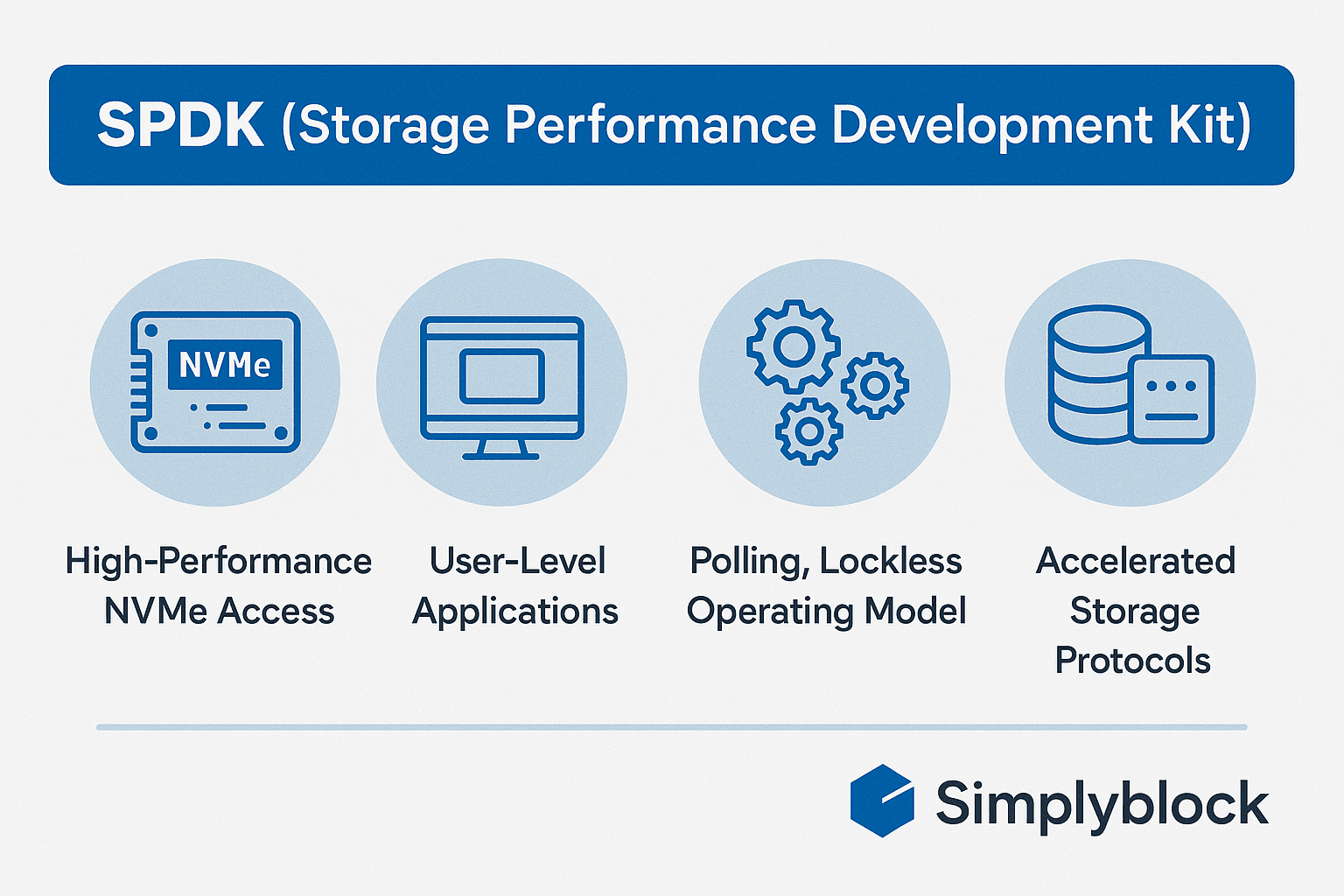SPDK (Storage Performance Development Kit)
Terms related to simplyblock
SPDK (Storage Performance Development Kit) is an open-source set of tools and libraries designed to accelerate storage applications, particularly for NVMe and NVMe over Fabrics (NVMe-oF). Developed by Intel, SPDK enables high-performance, user-space storage applications by bypassing the traditional kernel-based storage stack and leveraging direct memory access (DMA) for low-latency, high-throughput operations.
How Does SPDK Work?
SPDK operates by utilizing a user-space, polled-mode driver model, which eliminates context switches and kernel interrupts. This drastically improves IOPS (Input/Output Operations Per Second) performance and reduces CPU overhead. SPDK supports multiple protocols, including NVMe, NVMe-oF, and iSCSI, making it an ideal choice for cloud storage infrastructures and distributed storage systems.
SPDK also integrates seamlessly with Simplyblock’s NVMe over TCP storage solutions, enabling enterprises to build high-performance storage infrastructures with minimal latency.
🚀 Get NVMe Speed Without Building SPDK Infrastructure From Scratch
Use Simplyblock to deploy SPDK-powered storage that’s production-ready, scalable, and Kubernetes-native.
👉 Use Simplyblock for Database Branching →
Benefits of SPDK
- High Performance: Reduces CPU overhead by utilizing user-space drivers and polling mechanisms.
- Low Latency: Eliminates system calls and kernel intervention, leading to microsecond-level latencies.
- Scalability: Supports large-scale storage deployments, including cloud and edge environments.
- NVMe Optimization: SPDK enhances NVMe SSD performance, making it a crucial component of Simplyblock’s distributed storage systems.
- Open-Source and Flexible: Allows developers to customize storage applications for various enterprise needs.
SPDK vs Kernel-Based Storage
SPDK offers a significant advantage over traditional kernel-based storage stacks by eliminating unnecessary system overhead. The table below highlights key differences:
| Feature | SPDK | Kernel-Based Storage |
|---|---|---|
| Latency | Ultra-low (microseconds) | Higher due to kernel overhead |
| CPU Utilization | Optimized via polling | Higher due to interrupts |
| Performance | Near hardware speed | Limited by OS scheduling |
| Flexibility | Fully customizable | Limited by kernel constraints |

Use Cases for SPDK
- NVMe-based Storage Systems: Ideal for enterprises seeking ultra-fast SSD performance.
- Cloud Storage and Hyperscale Data Centers: SPDK optimizes NVMe storage in large-scale cloud environments.
- High-Performance Databases: Supports transactional databases like PostgreSQL and MySQL by minimizing storage latency. This makes it a solid foundation for platforms offering database performance optimization.
- AI and Machine Learning Workloads: Provides rapid access to high-throughput storage for data-intensive applications.
Challenges of Using SPDK in Production
While SPDK delivers impressive storage performance, it comes with a steep learning curve and infrastructure demands. Running SPDK requires a deep understanding of user-space memory handling, threading models, and NUMA-aware tuning. On top of that, integrating SPDK into existing environments often means rebuilding parts of the storage stack from scratch.
That’s why many teams struggle to adopt it at scale—especially in Kubernetes or hybrid cloud deployments where operational simplicity matters. Platforms like Simplyblock solve this by embedding SPDK’s performance benefits directly into a production-ready solution, making it ideal for teams working with cloud-native storage for Kubernetes without requiring custom tuning or specialized hardware.
SPDK and Simplyblock Integration
Simplyblock builds SPDK directly into its NVMe-over-TCP storage platform, bringing ultra-low latency and high throughput to Kubernetes environments—without the operational complexity. By abstracting away SPDK’s technical overhead, Simplyblock gives teams production-grade, NVMe-accelerated storage with sub-millisecond performance, ideal for stateful workloads, high-performance databases, and latency-sensitive cloud-native apps. It’s also a great fit for environments focused on cloud cost optimization, where efficient performance and infrastructure control are key.
Learn More
For additional insights on high-performance storage technologies, visit:
- NVMe Over TCP
- Distributed Storage Systems
- IOPS, Throughput, and Latency Explained
- Official SPDK Website
- SPDK on GitHub
Questions and Answers
SPDK enables user-space, asynchronous access to NVMe devices, bypassing traditional kernel I/O stacks. This dramatically reduces latency and CPU overhead—making it a cornerstone of high-performance storage solutions like Simplyblock’s NVMe-over-TCP platform.
By operating in user space and using polling instead of interrupts, SPDK eliminates context switches and accelerates data paths. It enables performance levels well beyond standard kernel drivers, making it ideal for SDS systems and Kubernetes-native block storage.
Yes, SPDK is used by major vendors and hyperscalers in production. While it requires deep expertise to integrate, platforms like Simplyblock SDS use SPDK under the hood to expose its performance benefits in a plug-and-play way.
SPDK lacks a traditional kernel abstraction, requiring developers to manage CPU cores, memory, and queues manually. This complexity is why most users prefer integrated solutions that build on SPDK rather than managing it themselves.
Primarily, yes. SPDK is designed for high-speed devices like NVMe and supports protocols like NVMe-oF and iSCSI. However, its architecture also supports other technologies like Virtio and Vhost for broader use in virtualized environments.
